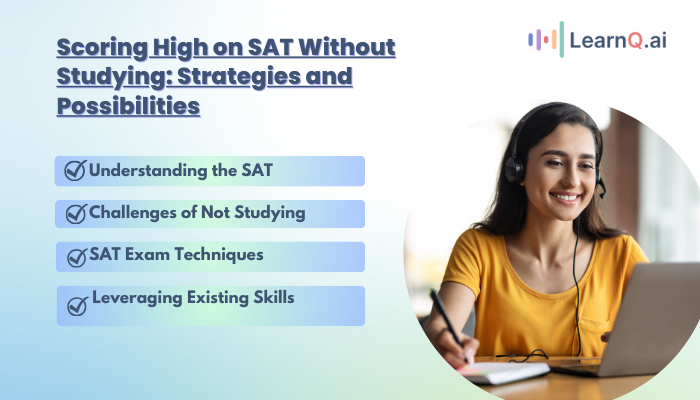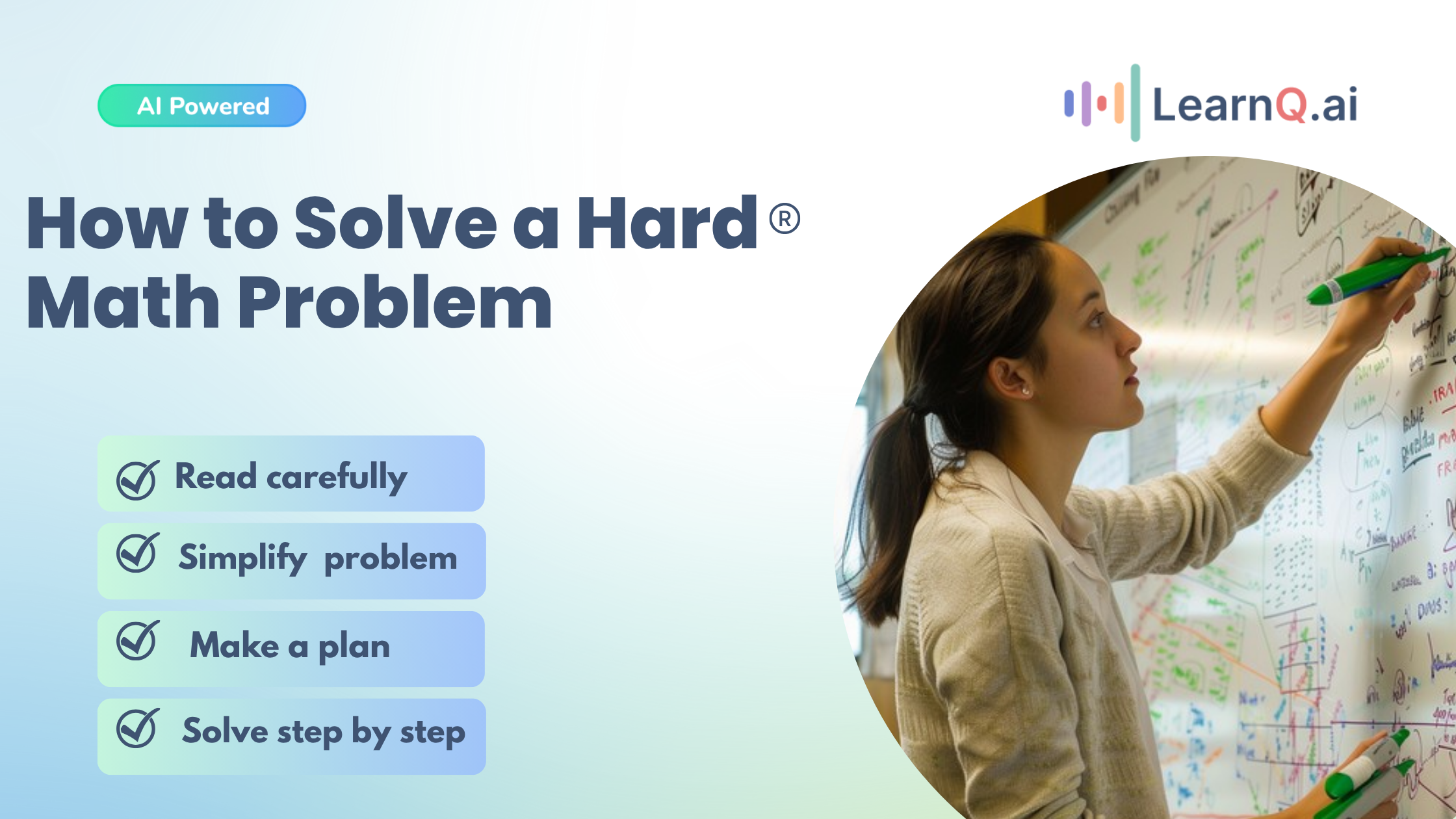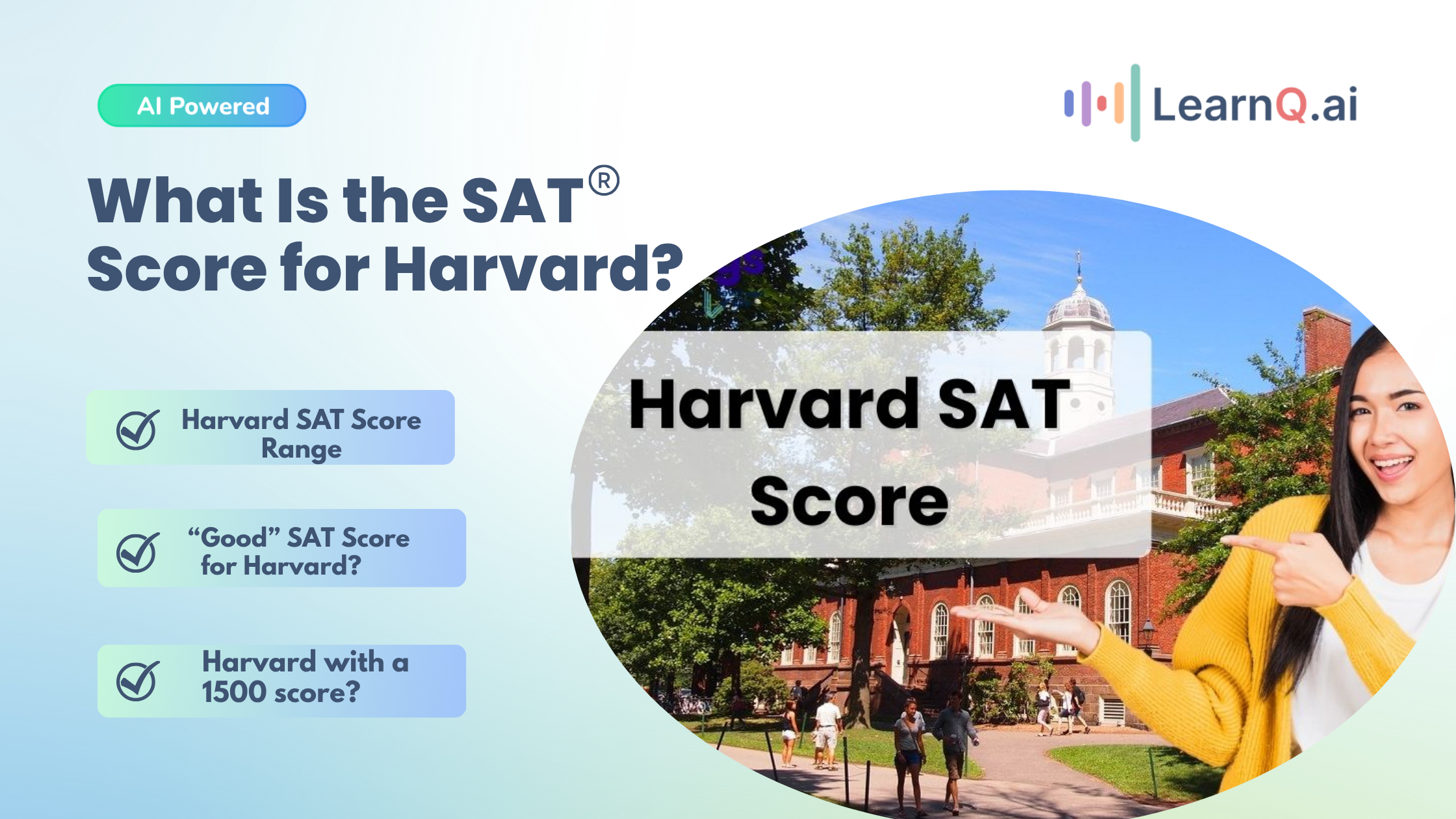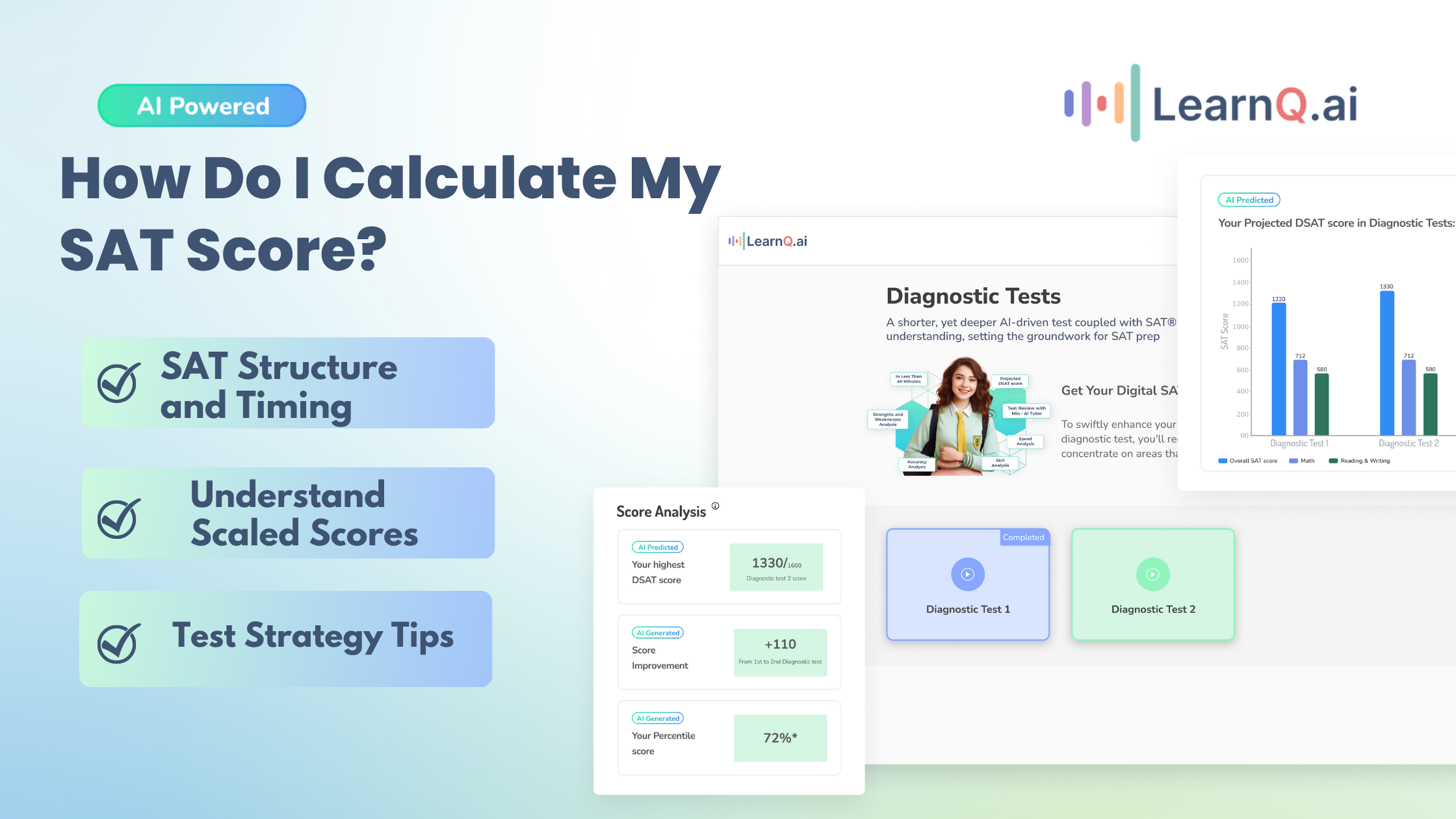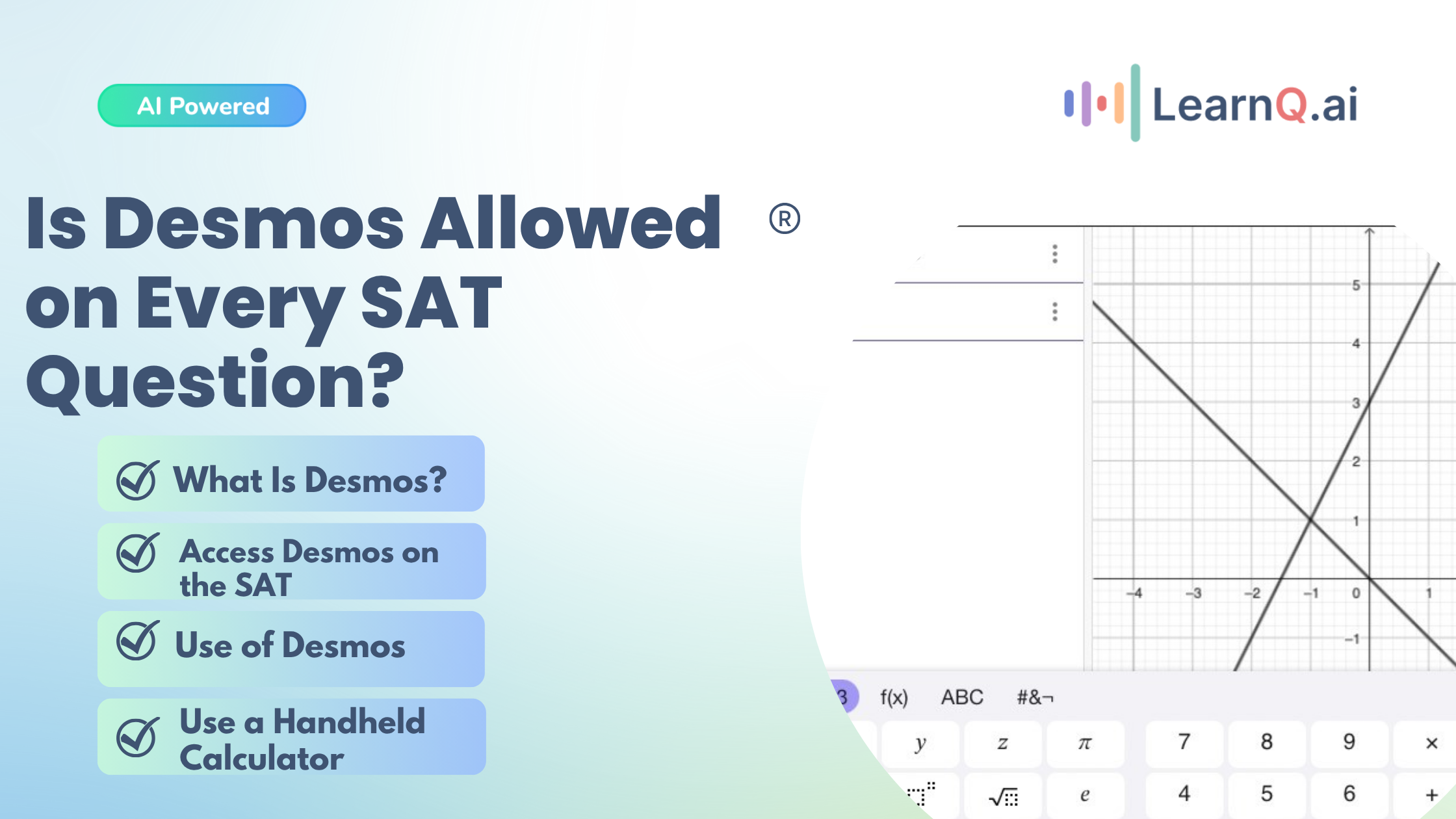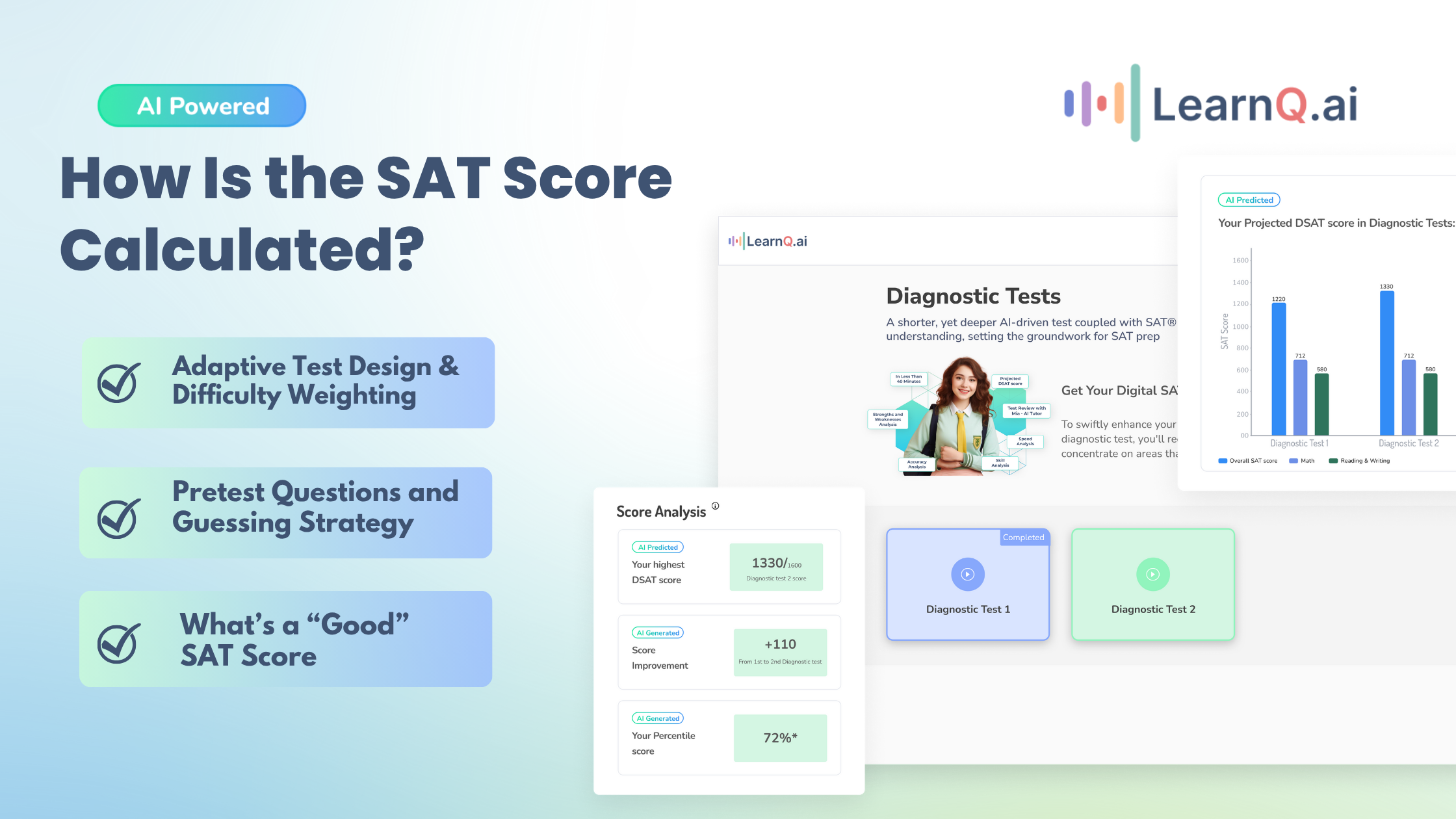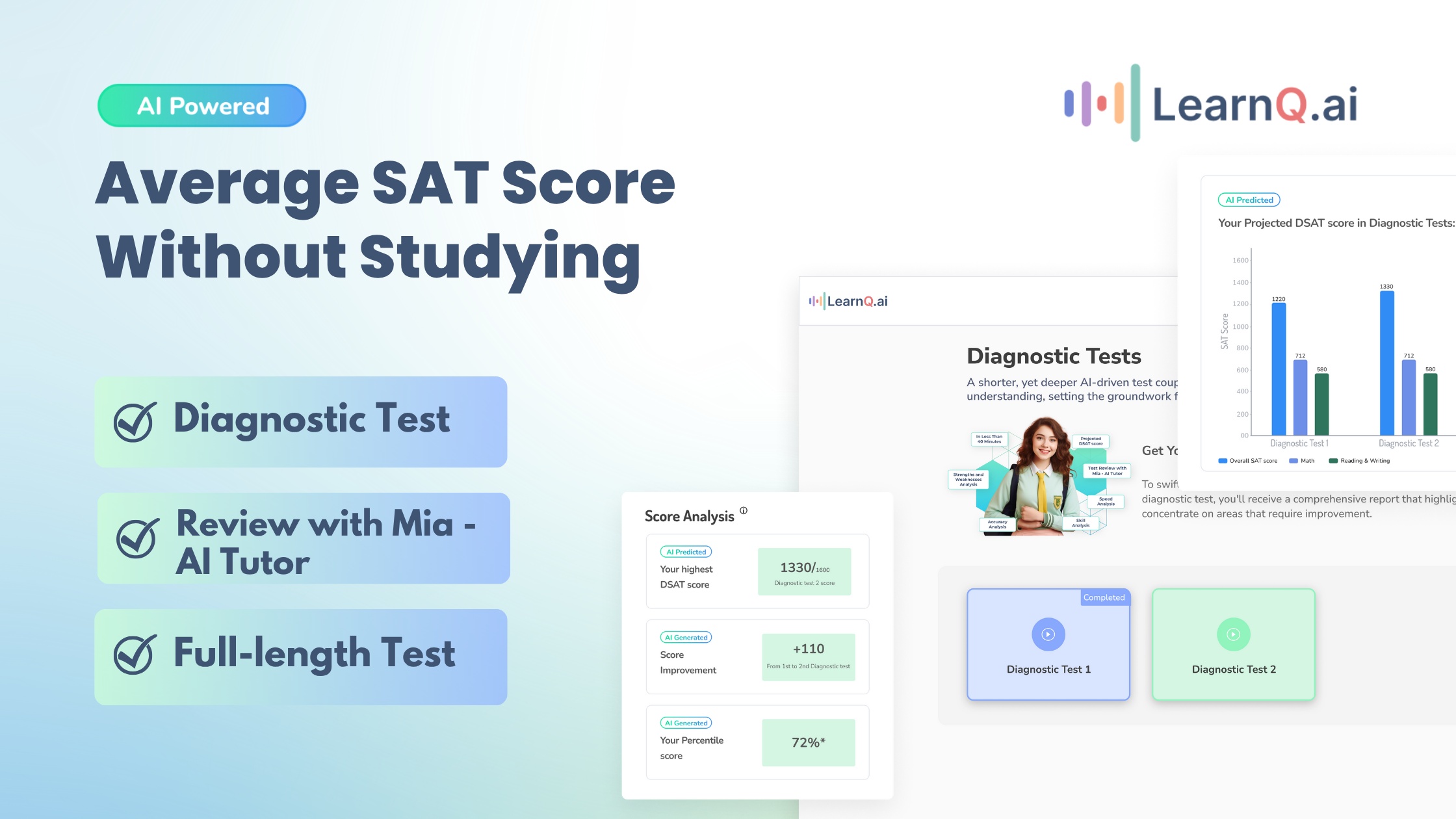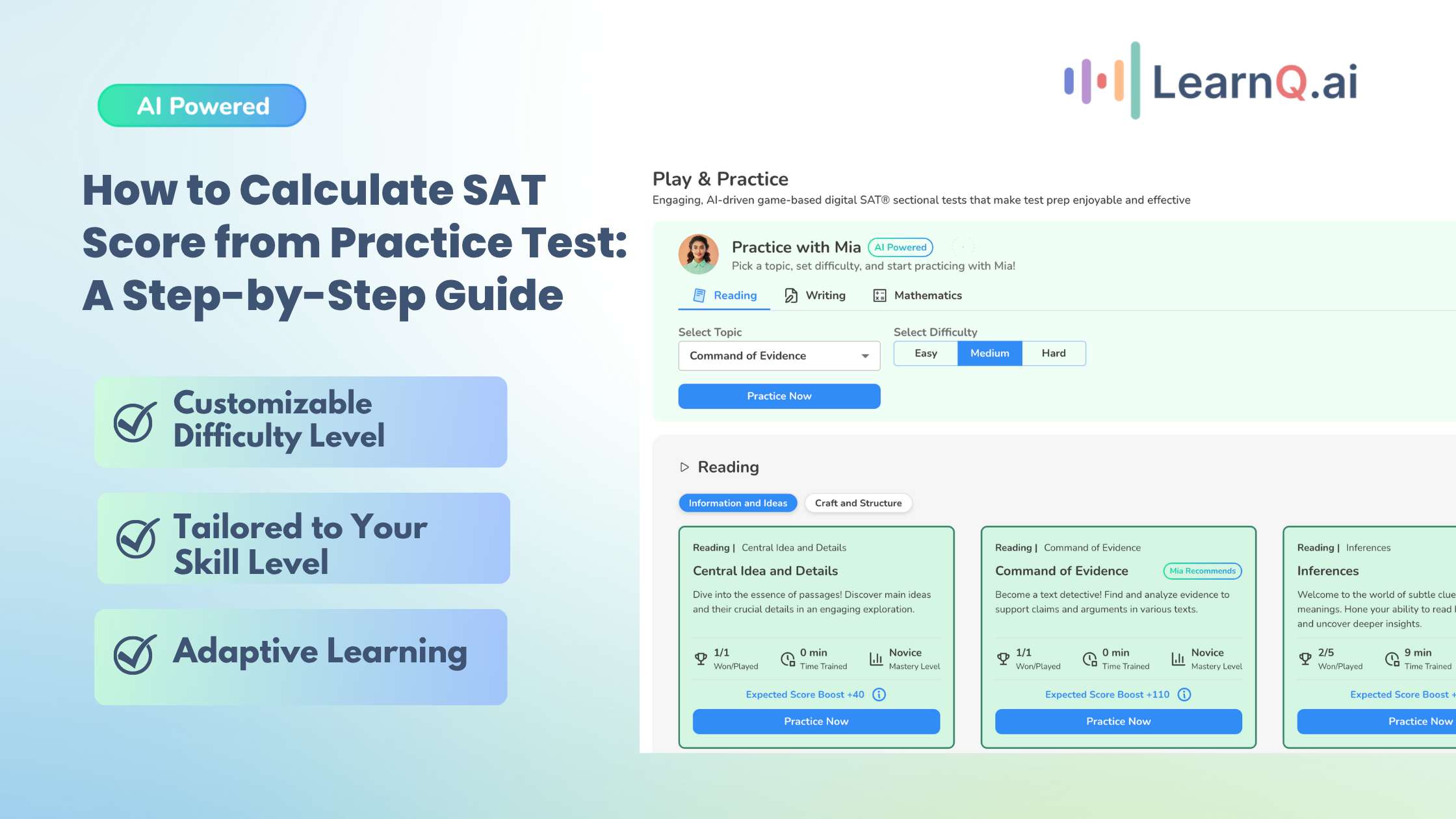Getting a high SAT score without traditional study sessions is all about smart, strategic preparation. LearnQ.ai is an AI-driven platform specifically designed to make SAT prep more efficient and targeted. It allows you to leverage your existing skills and use modern tools to maximize your score with less time commitment.
LearnQ offers a personalized learning experience with AI-powered diagnostics that quickly assess your strengths and weaknesses. From there, it provides customized practice plans that focus on the areas you need to improve, helping you bypass hours of broad study and instead target high-impact areas.
The platform also includes adaptive practice tests that closely mirror the Digital SAT format, integrating tools like the in-test calculator, highlighters, reference sheets, and timers that make the digital practice experience similar to the actual SAT environment.
LearnQ.ai is Powered by VEGA AI—Is your Institute Next?
Give students a Duolingo-style test-prep platform with Shopify-level customization for tutors and institutes.
This design helps you become more comfortable with the test format, improving both accuracy and timing under realistic conditions.
For added support, LearnQ provides access to Mia, an AI tutor, available for interactive help and real-time feedback on questions and concepts. This AI tutor adapts to your performance, giving step-by-step guidance and explaining solutions so you can understand concepts deeply, minimizing the need for lengthy traditional review sessions.
Plus, detailed analytics and progress tracking provide insights into your strengths, timing patterns, and areas for improvement, enabling you to fine-tune your approach for maximum efficiency.
In terms of accessibility, LearnQ has flexible pricing, including free access to basic features, allowing you to get started with personalized SAT prep without upfront costs.
Overall, LearnQ can help you study smarter, not harder, with tools that streamline the preparation process and empower you to reach your SAT goals confidently and efficiently.
Understanding the SAT and Score Implications
The SAT, designed by the College Board, isn’t about testing new information; rather, it measures the skills and knowledge students have developed over years of education.
This is why the SAT primarily assesses abilities in areas like reading comprehension, analytical writing, and mathematical reasoning. These skills are foundational and built over time through academic experiences rather than through last-minute studying or memorization.
The SAT Measures Existing Abilities and Skills
The SAT focuses on skills that students have already developed, such as critical thinking, problem-solving, and interpreting complex texts. For instance:
- Evidence-Based Reading and Writing (EBRW) measures comprehension, vocabulary in context, and analytical skills—skills developed from reading a variety of texts.
- Mathematics sections emphasize algebra, problem-solving, and data analysis, assessing a student’s ability to apply mathematical reasoning rather than test specific math facts or recently learned formulas.
This design aims to provide colleges with a clear view of a student’s readiness for higher education based on abilities built through consistent academic engagement. Since the test evaluates established skills, students can improve scores by refining strategies like time management and question analysis rather than learning new information from scratch.
Enhance your Digital SAT study routine with AI-driven insights and personalized practice tests.
Implications of Average and High SAT Scores on College Admissions
SAT scores are critical in college admissions because they help schools evaluate academic readiness on a standardized level, particularly as curricula can vary widely across high schools. The impact of your SAT score can be profound, affecting not just admissions but also scholarship opportunities:
- Average SAT Scores (Around 1050–1200): Scoring within this range places students around the national average, making them competitive for many state universities and some less selective private institutions.
However, schools with competitive admissions might require higher scores, so students scoring in this range may need to strengthen their applications with high GPAs, compelling essays, or strong extracurriculars.
- Above-Average SAT Scores (1200–1400): This range opens doors to a broader range of selective schools, including many public flagship universities and private colleges.
Higher scores in this range demonstrate above-average readiness for college coursework, often increasing the likelihood of receiving merit-based scholarships or honors program invitations.
- High SAT Scores (1400+): Scoring in this range significantly enhances your application to highly selective institutions like Ivy League schools, Stanford, and other top-tier colleges.
These scores can also strengthen applications to competitive scholarships, signaling academic ability, dedication, and preparation.
In general, higher SAT scores offer more admissions options, enhancing a student’s competitiveness at selective schools and sometimes even compensating for a lower GPA.
Furthermore, the SAT’s standardized nature means colleges rely on it as a benchmark to understand academic readiness across a diverse applicant pool.
Ultimately, while SAT scores alone do not determine college acceptance, they play a key role in supporting a student’s overall application profile and potential for financial aid.
Also Read: The Benefits of Taking a Full-Length Digital SAT Mock Test
Challenges of Not Studying for the SAT
Skipping SAT preparation can be risky, both for college prospects and personal well-being. The SAT is a test that rewards familiarity with its specific structure and pacing, so without some preparation, students risk scoring below their potential. This can limit their options for admission, affect financial aid, and lead to significant emotional stress.
Risk of Scoring Below Average Affecting College Choices
Without studying, the likelihood of scoring below average, typically below 1050, increases significantly. A low score can reduce eligibility for competitive schools, many of which use SAT scores as a key criterion in their admissions process.
Highly selective colleges often expect scores in the 1300–1500 range, so an unprepared test-taker’s lower score may disqualify them from these options. Furthermore, many state universities require minimum SAT scores for acceptance, meaning a low score can limit even moderately competitive options.
Financial aid can also be impacted. Many schools offer merit-based scholarships that consider SAT scores as part of the award criteria. A lower score may reduce a student’s chances of qualifying, making college both less accessible and more costly.
Potential Emotional Consequences Such as Stress and Loss of Confidence
Facing the SAT without preparation can lead to significant stress. The pressure of entering an exam without adequate preparation can trigger anxiety, especially since SAT scores play a pivotal role in college admissions. Feeling unprepared for the test can lead to negative emotions, which can affect performance and carry over into future academic efforts.
If scores come back lower than expected, it can decrease self-confidence. Many students interpret their SAT results as reflecting their academic potential so that a poor score may reinforce negative beliefs about their capabilities.
This loss of confidence may influence how they approach future exams, projects, and other academic challenges, ultimately impacting their educational journey.
Also Read: Digital SAT Practice Questions & Resources
Importance of Understanding SAT Format and Question Types
Knowing the SAT format and question types is a powerful way to prepare with minimal effort. Familiarity with the structure means fewer surprises, so you can dive into the questions confidently.
The SAT includes Reading, Writing, language, Math (Calculator and No-Calculator sections), and an optional Essay. Each section has unique question styles, from vocabulary-in-context to problem-solving equations.
Practice understanding these question types to save time during the test. Recognizing patterns also helps with faster, more accurate answers. Even a small amount of time spent reviewing sample questions can lead to a more efficient testing experience.
Effective Time Management and Practical Exam Tips
Time management is critical for maximizing your score. Each section has a time limit, so allocate time per question:
- Reading Section: Aim to spend about 1 minute per question.
- Writing and Language: Around 35 seconds per question.
- Math Sections: About 1 minute per question on the calculator section and slightly less for the no-calculator section.
Practical tips include flagging tricky questions to revisit and answering easier questions first. This strategy builds confidence and ensures you don’t miss out on points from questions you know.
Remember to monitor the clock and keep a steady pace, adjusting as needed. Practicing these techniques beforehand allows you to focus on the questions rather than the ticking timer, leading to a smoother SAT experience.
Leveraging Existing Skills and Abilities
Leveraging your current strengths in areas like Math and English is a strategic way to maximize your SAT performance. Focusing on these established abilities allows you to build a solid score base without needing extensive new study.
For example, if you’re strong in math, concentrating on problem areas like algebraic functions or data analysis can help you tackle questions more effectively and score consistently high in this section.
Similarly, for those with a natural inclination toward English, honing in on grammar rules, syntax, and reading comprehension can yield a powerful advantage in the Reading and Writing sections.
Also Read: Tips for Solving Problems on SAT Practice Test With Study Plan
Focusing on Strengths, Particularly in Math and English
With the SAT structured into distinct sections—each focusing on specific skill areas—playing to your strengths can give you a significant advantage. Concentrating on the areas in which you naturally excel, like math or English, means you’re building confidence and maximizing the scoring potential of the sections where you can perform your best.
- For example, focusing your preparation on the Reading and Writing section allows you to hone skills like critical reading and error identification, which can lead to quick wins on test day.
- Likewise, if Math is a strength, mastering algebraic equations, geometry, and data analysis can yield high-value points.
- This strategy provides a stable foundation that compensates for other sections where you might not perform as strongly, allowing you to maintain a competitive overall score.
Enhancing Performance Through Minimal Targeted Practice
Minimal, focused practice can be highly effective for sharpening your SAT skills without intensive, time-consuming study. Instead of exhaustive review sessions, aim for short, targeted sessions that cover specific skills within your strengths.
For instance, focusing on complex algebra problems for math, or quick grammar drills for English, lets you zero in on commonly tested concepts. Practicing with sample questions in these targeted areas not only increases your accuracy but also helps you become comfortable with the SAT’s format.
This approach enhances your speed and confidence, making the test feel familiar and allowing you to perform at your best on test day.
Read More: What is the Highest Score on ACT and SAT Tests?
Personal Experiences and Strategies
When it comes to the SAT, successful test-takers have shared numerous strategies and study habits that helped them achieve their goals with minimal prep. These experiences emphasize smart, strategic efforts over a sheer volume of study time, showing how targeted habits can yield high-impact results.
Enhance your Digital SAT study routine with AI-driven insights and personalized practice tests.
Various Personal Strategies and Habits for Test-Taking
- Prioritizing Strong Areas: Many students find that focusing on strengths is key to minimizing study time while maximizing results.
For instance, one student with a strong background in reading comprehension focused on practicing SAT-style reading passages for 10–15 minutes a day. By sticking to areas where they were already confident, they could build speed and accuracy without much additional study.
- Strategic Practice Timing: Another technique that some high-scorers swear by is studying in short, focused sessions.
One student reported that practicing one math section daily for just 20 minutes helped them master SAT question styles and avoid burnout. The student maintained focus by sticking to short sessions and saw consistent improvement without intensive preparation.
- Mock Testing for Familiarity: Several students recommend taking a full-length SAT practice test under timed conditions.
A few successful test-takers have reported that simply familiarizing themselves with test timing and structure allowed them to perform well on test day without deep content review. The mock tests were beneficial for managing pacing, as students could develop a rhythm for each section.
Insights and Reflections on Test Outcomes with Minimal Study
Many students adopting these minimal-prep strategies report that their scores met or exceeded their expectations. For instance, one student who had been a strong reader and writer achieved a 700+ score on the Evidence-Based Reading and Writing section by focusing only on timing and pacing without rigorous content study.
Others have shared that minimal prep gave them a sense of calm, reducing stress and improving performance.
By building confidence in their existing abilities rather than feeling pressure to over-prepare, they entered the exam with a positive mindset, translating to better focus and test-day success. These reflections underscore that, with the right strategies, minimal study can be highly effective.
Ultimately, these strategies demonstrate that solid SAT scores can be achieved by relying on smart habits and personal strengths rather than hours of cramming.
Misconceptions and Clarifications
The SAT often generates misconceptions, especially regarding its purpose and how scores are interpreted. Understanding the SAT’s real structure and intent can help students approach it with a clearer perspective and more effective strategies.
The SAT: A Measure of Personal Achievement, Not a Pass/Fail Test
Many students misunderstand the SAT as a pass/fail test, but this exam actually provides a score range from 400 to 1600. Rather than aiming for a universal passing score, students should focus on their personal best.
A good SAT score is relative to a student’s goals and chosen colleges. For instance, a 1200 may be competitive for one school but not for another, making it essential to view the SAT as a tool for showcasing individual achievement.
The SAT’s Role in College Admissions and Beyond
While important in college admissions, the SAT is one part of a larger application. Admissions officers consider SAT scores alongside GPA, essays, extracurriculars, and recommendations. For career paths, SAT scores are less relevant than college degrees, skills, and experiences.
By understanding the SAT’s role in educational and career planning, students can keep the test in perspective, viewing it as a means of strengthening college options rather than a lifelong success metric.
How LearnQ Enhances Efficient SAT Preparation for Students and Educational Partners
LearnQ offers an innovative SAT prep experience that’s appealing to students aiming for efficient results and to educational institutions or tutoring centers looking to elevate their test prep offerings.
Combining adaptive technology, AI-driven analytics, and interactive engagement, LearnQ optimizes study sessions for maximum impact. Here’s how it effectively serves both groups.
- Adaptive Practice Tests and Personalized Learning
For Students: LearnQ’s adaptive tests adjust to your performance level, tailoring questions to focus on areas where you can improve the most. This personalized approach allows students to concentrate on their weaker skills without wasting time on concepts they’ve already mastered, making study time more efficient and focused.
For Educators and Tutors: This feature offers a powerful way to guide students without requiring a one-size-fits-all approach. By incorporating adaptive tests, LearnQ ensures that each student’s unique strengths and challenges are addressed.
- AI-Powered Analytics and Strategic Insights
For Students: LearnQ’s analytics tools provide comprehensive insights into pacing, accuracy, and specific section scores. You can quickly see where you excel and which areas require more practice.
The Pace and Accuracy Analysis tools let students identify patterns and fine-tune their test strategies, whether they’re managing time in the math section or reducing errors in reading comprehension.
For Partners: LearnQ’s analytics dashboard provides real-time access to student progress and performance for tutoring centers and test prep programs. This feature allows educators to monitor group performance and individual improvement, making it easy to provide targeted support.
- “Review with Ask Mia” for Focused, Interactive Support
For Students: The “Ask Mia” feature offers a unique advantage by providing immediate, personalized assistance. After a practice session, Mia—a responsive AI tutor—breaks down missed questions and provides similar exercises to reinforce learning.
For Tutors and Educational Centers: The “Ask Mia” tool adds a self-guided tutoring element that complements in-person instruction. By giving students access to Mia’s personalized review, educational centers can expand their tutoring reach and reduce hands-on instruction time while still ensuring that students receive detailed, in-depth explanations.
- Game-Based Practice and Engagement Boosters
For Students: LearnQ incorporates game-based practice options that add motivation and make learning more engaging. You can set goals, track mastery levels, and practice skills through interactive games, transforming study sessions into a rewarding experience. This approach helps reduce study fatigue, making learning less daunting and more enjoyable.
For Partners: For educational institutions, game-based learning can differentiate their SAT prep offerings. Gamified learning attracts students who might otherwise shy away from traditional study methods, improving overall engagement and retention.
LearnQ.ai is powered by VEGA AI—Is your institute next?
Offer students a Duolingo-style test-prep platform with Shopify-level customization for tutors and institutes.






Conclusion
Achieving a high SAT score with limited preparation is all about strategic focus. Prioritizing your strengths, understanding the test format, and managing your time wisely are key steps that allow you to maximize each study session.
By leveraging tools like LearnQ, which offers adaptive practice, AI-driven analytics, and personalized support through features like “Ask Mia,” you can focus your efforts on areas where you can see the greatest improvement.
Understanding your unique strengths and weak spots is critical, as is using efficient, targeted resources. LearnQ’s platform offers tailored practice that adapts to your performance, helping you streamline your prep without overwhelming study time.
LearnQ.ai offers a powerful edge in SAT preparation. It provides targeted practice questions and concept videos that adapt to focus on areas where you need the most support. With built-in progress tracking, you can easily monitor improvement and refine your study strategy along the way.
For both students and educational institutions, LearnQ.ai presents an adaptive, scalable platform that enhances learning and boosts SAT readiness. It equips you to approach the test with confidence and a focused skill set.

